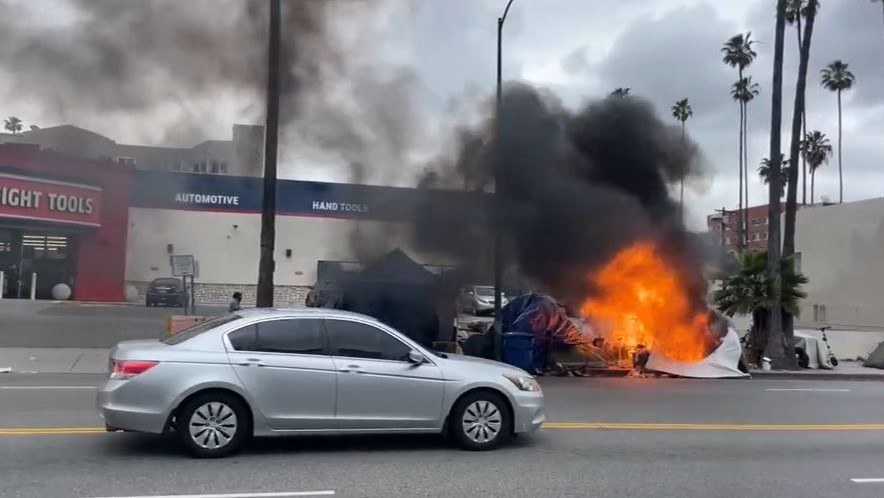Monorail may best be known to many as a ride at Disneyland, a 1950s vision of our transportation future. But half a century later, that future may be about to arrive in a mission to cut congestion in one of LA's worst traffic quagmires.
As transit planners revise and narrow the contenders for rail transit through the Sepulveda Pass, a monorail proposal has made the cut for the final four.
The 405 freeway through the pass has long remained one of LA's most intractable traffic challenges, a choke point between the Westside and the San Fernando Valley. Improvements nearly a decade ago during a previous project that culminated in "Carmageddon" added carpool lanes and upgraded overpasses, but did little to ease traffic.
Fixing the Sepulveda Pass is one of the priorities for the Measure M revenue that LA County voters approved in 2016. Three of the other options in the running would use so-called "heavy rail" in routes that would burrow through the Santa Monica mountains as subways. All would be expected to carry more than 100-thousand passengers a day, and thereby ease traffic for the cars on the 405 Freeway.
A surface or elevated route going up and over the pass would not be an option for traditional rail, said Metro's Sepulveda Corridor project co-manager Peter Carter at a community meeting Tuesday night, explaining that the grade on the valley side of the pass is too steep for steel wheels on steel rail. But the rubber tires of a lighter monorail would have sufficient traction to handle the climb and descent, he said.
Expense projections have risen, in part because Metro planners now believe the rail length should be extended to reach the Van Nuys Metrolink station to the north, and the Expo line on the south side. Originally it was hoped the Sepulveda Pass transit could be done for under $6 billion. Metro's current projections range from $9.4-13.8 billion.
Monorail is projected to be at the lower end of the price range, but whether to go above ground or below is proving to be an issue of contention in some communities. The Sherman Oaks Homeowners Association is opposing the alignment of monorail elevated above Sepulveda Blvd., contending it would be too noisy and too intrusive in the community. Instead of that, the association would prefer subway all the way, according to Board Member Bob Anderson.
News
Top news of the day
"We won't stand for the elevated trains," Anderson said.
Anderson has another suggestion that has been embraced by the association: a monorail located in the median of the 405 freeway, as Metro has done elsewhere with light rail, notably with the Gold Line on the 210 freeway, and the Green Line elevated above the 91 Freeway.
But a median alignment on the 405 freeway is not specifically included among Metro's list of contenders. At the Tuesday meeting at the Proud Bird Event Center near LAX, Carter indicated that compared to the straight and flat 91 and 210 freeway alignments, the grade and curves in the Sepulveda Pass present challenges, including interference with sight lines. Another factor is that Metro is already planning to use the 405 median for express lanes. What's more, between the 101 freeway and Sherman Way, the 405 has no median, so traffic lanes would have to be sacrificed to make room, Carter said.
Other community organizations are holding off on choosing a preferred alternative. The Brentwood Community Council is awaiting additional details, timelines, and construction plans, said Chair Michelle Bisnoff.
There is pressure on Metro to complete the Sepulveda Corridor project before the summer of 2028, when Los Angeles will again host the Olympic Games. A later second leg would extend to LAX, but not for three more decades.
To expedite the process and perhaps also cut expenses, Metro is considering a form of public-private partnership known as a pre-development agreement (PDA) with a contractor that would begin during the environmental review process, Carter said. Whether to authorize pursuing a PDA is scheduled to be considered Thursday by the Metro Board.
The Chinese company BYD has developed a monorail system it calls "Skyrail," which the company says offers lower cost of construction and operation and a smaller footpprint. BYD has a presence in southern California with a Lancaster factory building electric buses. Regarding the Sepulveda corridor project, BYD has already been in contact with Metro, and also with the Sherman Oaks Homeowners Association, Anderson said.
Serial entrepreneur Elon Musk, founder of The Boring Company, has been exploring the potential for underground transportation networks, but last year announced it was abandoning plans to dig a test tunnel beneath the Sepulveda Pass.
Carter expects Metro staff will present the board with its recommended alternative before year's end.
If monorail is chosen, it would be the first time for a transit project in LA County.



